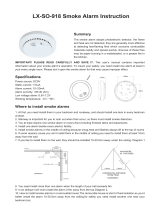9. NRC INFORMATION
Ionization type smoke alarms use a very small amount of a
radioactive element in the sensing chamber to enable detection of
visible and invisible combustion products.
The radioactive element is safely contained in the chamber and
requires no adjustments or maintenance. This smoke alarm meets
or exceeds all government standards. It is manufactured and dis-
tributed under license from the U.S. Nuclear Regulatory
Commission.
10. NFPA REQUIRED PROTECTION
The National Fire Protection Association’s Standard 72 provides the
following information:
Smoke Detection - Where required by applicable laws, codes, or
standards for the specified occupancy, approved single- and multi-
ple-station smoke alarms shall be installed as follows: (1) In all
sleeping rooms Exception: Smoke alarms shall not be required in
sleeping rooms in existing one- and two-family dwelling units. (2)
Outside of each separate sleeping area, in immediate vicinity of
the sleeping rooms. (3) On each level of the dwelling unit, includ-
ing basements Exception: In existing one- and two-family dwelling
units, approved smoke alarms powered by batteries are permitted.
Smoke Detection - Are More Smoke Alarms Desirable? The
required number of smoke alarms might not provide reliable early
warning protection for those areas separated by a door from the
areas protected by the required smoke alarms. For this reason, it is
recommended that the householder consider the use of additional
smoke alarms for those areas for increased protection. The addi-
tional areas include the basement, bedrooms, dining room, fur-
nace room, utility room, and hallways not protected by the
required smoke alarms. The installation of the smoke alarms in
the kitchen, attic (finished or unfinished), or garage is normally not
recommended, as these locations occasionally experience condi-
tions that can result in improper operation.
This equipment should be installed in accordance with the
National Fire Protection Association’s Standard 72 (NFPA,
Batterymarch Park, Quincy, MA 02269).
NOTIFY YOUR LOCAL FIRE DEPARTMENT AND INSURANCE COM-
PANY OF YOUR SMOKE ALARM INSTALLATION.





















